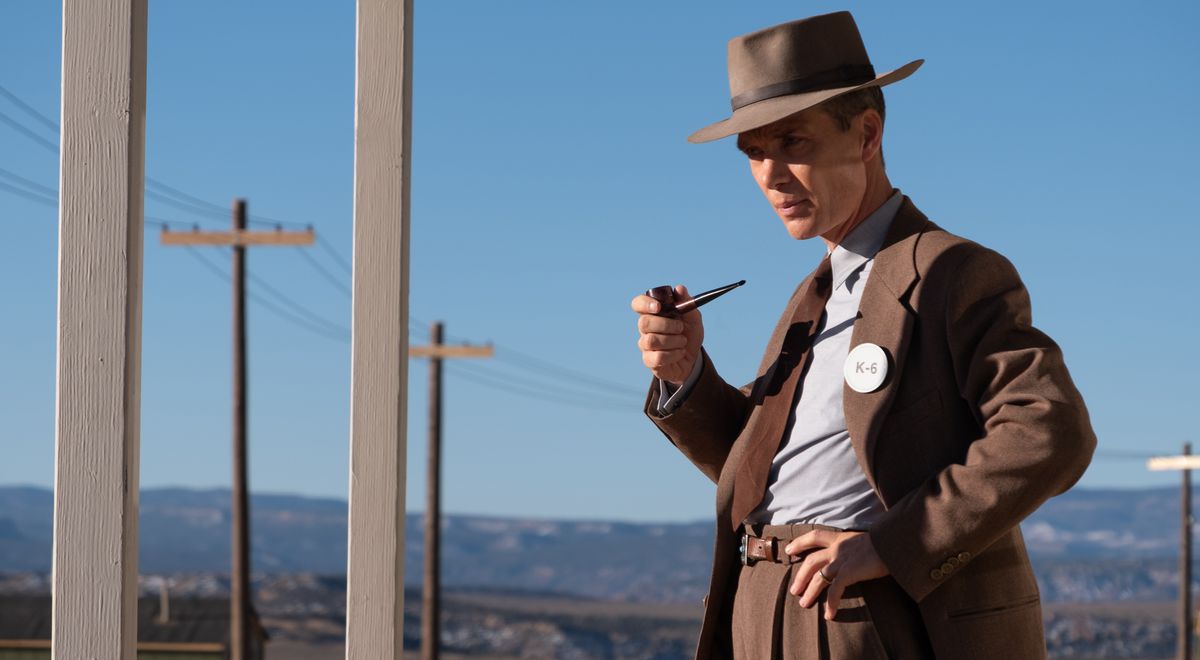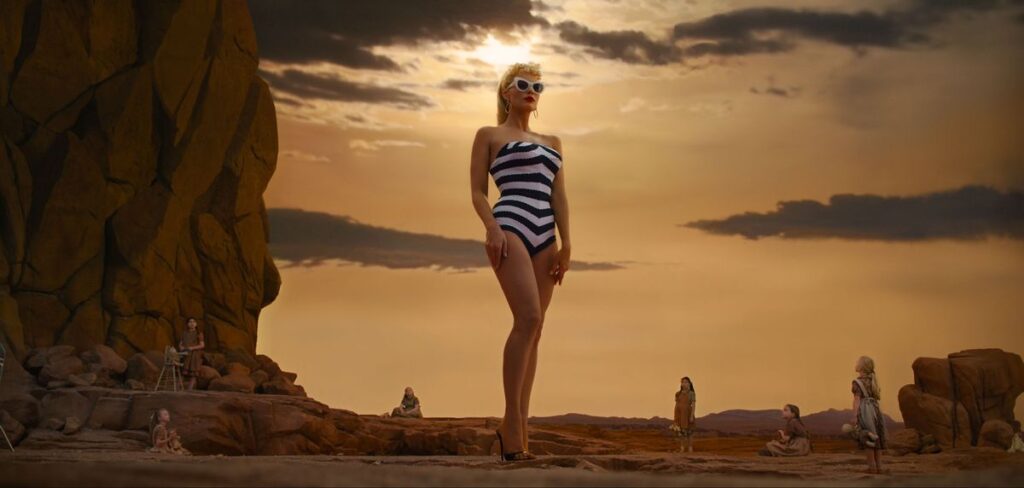Barbie and Oppenheimer’s box-office fates have been enmeshed until the movies have reached portmanteau status, jointly christened “Barbenheimer” as if People Magazine caught the physicist and the foot-tall plastic doll canoodling together on a Malibu beach. The films’ shared release date has inextricably linked the narratives of their success or failure, and a hybridized fandom has evolved from viral memes to custom T-shirts and mass ticket sales for back-to-back viewing of the two movies.
Those intrepid souls going that double-feature route have used social media to ponder the optimal schedule for ingesting two massive hunks of movie. That deliberation has generally boiled down to a binary choice between good vibes at one pole, and devastation on an epochal scale at the other.
But Barbie hinges on an existential crisis spinning into a depressive spiral set in motion by the fear of death, while Oppenheimer finds plenty of room for popcorn wisecracks between its weighty considerations of oblivion. Either way you watch them, these seemingly disparate blockbusters can read as two halves of a single thematic whole.
Image: Warner Bros. Pictures
The most overt connections between these unlikely duelists for the summer movie crown are just about classification. They’re uppermost-tier productions made under studio banners with budgets to match, respectively commandeered by a pair of name-brand auteurs: Greta Gerwig for Barbie, Christopher Nolan for Oppenheimer. The directors have both spent plenty of time thinking and talking about the state of the Great American Movie; they’re de facto keepers of its flame, and their concerns have now filtered into the subtext of their latest works. In tonal registers far removed from each other, Barbie and Oppenheimer each focus on an icon wrestling with responsibility and complicity, trying to grasp how enormous and central they are to the fabric of their world.
Through the struggle to maintain autonomy while functioning with large institutional systems — a concept that bridges these movies’ gap between gender politics and just plain politics — they reach conclusions at different points in the same thought process. Exasperated yet inexhaustible, Barbie reads like a statement from an artist doing her optimistic best to remain herself while maneuvering through the Hollywood machine. Bleak and defeated even in its triumphs of craft, Oppenheimer comes from someone who has long since abandoned hope for the big picture of big pictures.
Gerwig opens on an allusion to 2001: A Space Odyssey presented — like almost everything in her chronically self-aware riff on itself — with plastic tongue partially in cheek. Margot Robbie takes the place of the towering obsidian monolith that bestows the gift of invention on the crafty apes of prehistory in Stanley Kubrick’s classic. That image positions the Barbie doll as the most important creation in the timeline of our species.
To an extent, the film believes that’s true: Voiceover narration from Helen Mirren pops in to explain the profound significance of the adult surrogacy this toy offers young girls. The script introduces Barbie as a feminist role model inspiring the girls of America to seek doctorates, Nobel Prizes, or the presidency. Then it concedes that’s far too much to expect from a Mattel product, especially one with a record of promoting problematic bodily proportions.

Photo: Warner Bros. Pictures
And yet there’s no denying the bond innumerable girls nonetheless feel with their playtime best friend. As Barbie journeys from her fantasy dimension of artifice to reality and back, she fields constant challenges to her self-image, and finally settles on a simple humanity captured in a perfect punchline.
Barbie’s third-act ambivalence about What Barbie Means never really resolves, but Gerwig and co-writer Noah Baumbach hover around the notion that she can be whatever she needs to be for whoever wants her. It’s a close corollary to the thesis on womanhood summed up in an monologue by America Ferrera’s normie character, at the end of her rope with the unrealistic expectations and absurd double standards imposed on women. They must be yielding without coming off like pushovers, sufficiently feminine but not bubbleheaded, serious but not too serious. The parting sentiments take the shape of a plea to just let women live, for the love of God. (For the film’s purposes, God is Barbie creator Ruth Handler.)
And it’s easy enough to map this forbearing attitude onto Gerwig herself, as she reckons with the demands and limitations of commercial filmmaking. A contract to oversee one of Warner Bros.’ most expensive box-office bids of the year comes with 145 million strings attached, but she held fast to the personality and insight that earned her benefactors’ confidence in the first place. A highway-width subversive streak animates Barbie’s surreal adventures, which include more uses of the word “patriarchy” than you’d expect to hear in an afternoon at the multiplex.
At the same time, Gerwig mounts her eye-popping feats of soundstage production design on the dime of a toy manufacturer that will directly and materially benefit from her labor. That’s an uncomfortable truth spun into winky, self-deprecating jokes. The film’s overall policy of abiding pragmatism applies here as well: Gerwig is taking the money, getting away with everything she can, and just trying to make something she can proudly put her name on. “It is what it is” may not be the sturdiest rationalization, but it gets plenty of us through the day.

Photo: Melinda Sue Gordon/Universal Pictures
Barbie sweats the contradictions of being an original, expressive, individualistic work of art produced under the auspices of a corporation, which turns Oppenheimer into a nightmare projection of its worst-case scenario. Nolan traces the moral arc of J. Robert Oppenheimer, the Manhattan Project physicist who pivoted to urge against nuclear proliferation after beholding the incineration he made possible at Nagasaki and Hiroshima.
In Nolan’s movie, Oppenheimer (played by Cillian Murphy) locks horns with government functionaries again and again during the development process, adamant that the terrible Promethean ability to split an atom should be used to enforce peace rather than bolster strategic advantage. His naïveté, combined with his self-reassurance that the Nazis will build the atom bomb if he doesn’t, leads him to unleash a destructive capacity humankind never should have accessed. Just as Oppenheimer has woken up to the full catastrophic scope of his handiwork, the feds collude to squeeze him out of the program he started by sullying his reputation and focusing on his past Communist ties. Spending so much of his life as the smartest man in the room, he couldn’t see when he was being used.
As is recommended with sub-molecular tinkering, Oppenheimer runs his Los Alamos laboratory and testing site with the utmost care, all trust placed in the expertise of his judiciously selected collaborators. Once the eggheads have served their purpose, however, Uncle Sam’s flunkies cart away the A-bomb with plans to exponentially upgrade its megatonnage by using hydrogen. The account of a man convincing himself he’s making something personally meaningful, only to watch in horror as his government appropriates it and uses it for its own dystopian ends, lends itself to industry allegory twinning the “father of the atomic bomb” with the father of the modern superhero tentpole.

Photo: Universal Pictures
Nolan made his Batman trilogy in accordance with the lofty standard he sets for himself, only to ignite a chain reaction that’s now bombarded the market with factory-line CGI eyesores. Given all his passionate boosterism for analog film tech, it stands to reason that Nolan has looked down at his hands and wondered what horrors he hath wrought at least once or twice upon seeing the latest developments in the DCEU.
Massive, idiosyncratic expressions of directorial vision at the studio level come along so infrequently that a neutral contingent within Team Oppenheimer and Team Barbie can agree on this weekend’s double dose as a sign of robust health for the movies. The content of the films themselves tells a different story. Both of these movies are uneasy — to the point of outright despairing — about whether people have the latitude to do right under a system that’s militantly opposed to independent volition. Whether it’s depicted as a flawed fantasyland or a vast spiritual wasteland, Hollywood makes for hostile terrain. Even for those with the determination to traverse it and the endurance to reach its higher grounds, making it to the top like these two movies have just provides a clearer view of how rough it’s gotten out there.
Barbie and Oppenheimer are both in theaters on July 21.

